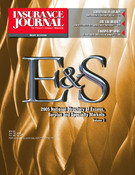Bush Administration Policy Questions Need for Renewal of Federal Backstop
Asked what the world would be like if there were no federal terrorism insurance backstop, the Treasury Department simply shrugged.
The loss of the current federal backstop, the Terrorism Risk Insurance Act, which expires at the end of the year, would have no major consequences for the economy or the insurance industry, the Bush Administration’s report suggests. Some businesses might have trouble getting coverage and others might end up paying more than they like, but overall, it should be no big deal because private insurance markets will step in to plug the holes. In fact, extending TRIA could make matters worse by hindering the development of the post-9/11 insurance market, in Treasury’s view.
The Treasury Department view puts it at odds with reports from The Columbia School of Business, Rand Corp., General Accountability Office, insurance broker Marsh Inc. and the Organization for Economic Cooperation and Development and others that have recommended renewal of TRIA. It complements, however, the views expressed by the Consumer Federation of America and the Congressional Budget Office. (See separate summary of terrorism reports on page N9.)
Economic impact
It’s “quite likely, impossible” to come to precise conclusions about the macroeconomic effects of subsidizing terrorism insurance, the Treasury authors state. Decisions by businesses and even individuals’ residential choices may be influenced by the threat of terror activity for years to come. For example, owners may locate manufacturing plants and office buildings further from central cities, which could then stimulate economic activity. Security-related industries and occupations might see growth.
The report does look a bit more closely at the potential impact on one sector of the economy, nonresidential construction, only to conclude there should be no big effect there either. Nonresidential building activity tumbled about 33 percent in the fourth quarter of 2001, and continued to experience declines in excess of 15 percent in the subsequent three quarters. But the report maintains that since the economy was falling before the terrorist attacks, there was no way to know how much of the subsequent economic fall-off was due to the terrorist attacks. “It was difficult at the time to assess whether the substantial declines in nonresidential building were due to the chilling effect of terrorist activity, terrorism insurance issues or the result of a cumulative unwinding of activity more typical of a recession,” Treasury writes.
Looking at the economy now, however, Treasury is comfortable concluding that the fall-off in nonresidential construction had little or nothing to do with terror insurance concerns. This conclusion rests on the finding that despite a greatly improved economy, nonresidential building has rebounded only slightly and is currently only 4.2 percent higher than the trough reached in the first quarter of 2003. “From our current perspective it appears that neither the potential lack of terror risk insurance nor a general economic downturn were responsible for weakness in nonresidential building activity.”
But even if the causes of the nonresidential downturn were known, it wouldn’t matter much, according to Treasury. Nonresidential building is only 2.2 percent of GDP, and commercial office construction is only 12.2 percent of the nonresidential building total. “Given the small size of nonresidential and commercial office construction, stimulating this sector (whether through TRIA or otherwise) would be neither effective nor warranted,” it concludes.
Insurance impact
How the insurance industry responds and fares if there is no federal reinsurance will be largely tied to insurers’ surplus situation, according to the report. The report estimates that a terrorist attack causing $50 to $60 billion in losses (a lot more than Sept. 11) would reduce the surplus of insurers and reinsurers on TRIA-eligible coverages by as much as 20 to 25 percent. The surplus on TRIA-eligible lines was $373 billion at third quarter 2004, $211 billion of which was surplus of the top 25 insurer groups.
Since insurance company rating agencies start thinking about downgrading if an insurer’s loss exposure to catastrophes rises significantly above 10 percent of surplus, insurers may have to alter their approach to terrorism risk insurance, once they are certain of TRIA’s expiration, the authors point out. Insurers might decide to continue to provide the same coverage but at higher market prices, purchase additional reinsurance or raise capital to accommodate this coverage; limit their exposure; or any combination.
The authors expect that insurers will adopt terror coverage exclusions permitted by most (except New York, Georgia and Florida) states. Some insurers are already capping their loss exposure by writing separate limits on losses due to TRIA attacks. There is no discussion of what happens in states where exclusions are not permitted.
“Overall, our assessment is that the immediate effect of the removal of the TRIA subsidy is likely to be less terrorism insurance written by insurers, higher prices and lower policyholder take-up,” the report said. How much less insurance will insurers write? How high might premiums go? How many more businesses will go bare? The answers are not in this report.
Whatever problems may come after ending the federal backstop, they should only be temporary, according to the report, because private markets will eventually take over. The authors’ faith in private markets appears to flow from their assessment of current conditions. Their surveys of the current marketplace prompted them to conclude that “terrorism risk in much of the country is now and has been broadly insurable and that it is partially insurable even for attacks that could lead to large losses.”
To support their prediction, the authors cite evidence that terrorism risk insurance capacity has increased; insurers are increasingly pricing terrorism risk insurance; and insurers are reinsuring a substantial portion of their retained risk, although they acknowledge that purchases of reinsurance have flattened.
Topics Catastrophe Carriers Excess Surplus Reinsurance Market Construction
Was this article valuable?
Here are more articles you may enjoy.


 Florida Public Adjuster, Renter Charged With Filing Claim on Rental Home
Florida Public Adjuster, Renter Charged With Filing Claim on Rental Home  Cargo Owners in Baltimore Disaster Face ‘General Average’ Loss Sharing, MSC Says
Cargo Owners in Baltimore Disaster Face ‘General Average’ Loss Sharing, MSC Says  Progressive Records Five-Fold Increase in Q1 Net Income
Progressive Records Five-Fold Increase in Q1 Net Income  Soaring Insurance Costs Hit as US Buyers Finally Get a Break on Car Prices
Soaring Insurance Costs Hit as US Buyers Finally Get a Break on Car Prices 


